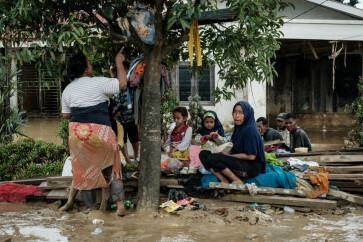Popular Reads
Top Results
Can't find what you're looking for?
View all search resultsPopular Reads
Top Results
Can't find what you're looking for?
View all search resultsCement players eye flat sales growth, seek consolidation
Cement maker Indocement Tunggal Prakarsa, part of the Salim Group, said the company faced many challenges last year due to the increase in coal prices, the rupiah depreciation and cement oversupply.
Change text size
Gift Premium Articles
to Anyone
B
ig cement producers will continue their cost-efficiency strategy and seize opportunities to acquire other players amid a cement oversupply that has consistently dragged down their financial performances.
Cement maker Indocement Tunggal Prakarsa, part of the Salim Group, said the company faced many challenges last year due to the increase in coal prices, the rupiah depreciation and cement oversupply.
“Our production costs from coal increased by 40-55 percent last year,” said Indocement president director Christian Kartawijaya in Jakarta recently.
The publicly listed company has posted a decline in net income for four consecutive years since 2015. The firm’s revenue was up 5.26 percent year-on-year (yoy) to Rp 15.19 trillion (US$1.06 billion) last year. However, its net income plunged 38.4 percent yoy to Rp 1.15 trillion.
To anticipate declining profits, Indocement has prepared a long-term strategy to substitute coal with alternative, refuse-derived fuel (RDF). In September, Indocement collaborated with the West Java administration to buy 500 tons of RDF derived from 1,500 tons of processed community waste.
In 2019, Indocement is targeting a conservative sales growth of 4 percent to Rp 15.8 trillion on the back of a slowdown in cement consumption. Christian predicts demand for cement to pick up in the second half of 2019, after the April 17 presidential election.
It believes cement consumption will be driven by government infrastructure and the construction of residential projects and buildings, either in Java or outside Java.
Indocement has set aside Rp 900 billion to Rp 1 trillion in capital expenditure (capex) that would be sourced from internal cash. The capex would be used for business expansions, including adding a quarry in West Java to support production and the completion of cement terminals.
The country’s cement industry is still sluggish. Domestic consumption grew by only 4.9 percent to 69.51 million tons last year, according to data from the Indonesia Cement Association.
Demand for cement is concentrated in Sumatra and Java, which contributed 74 percent of total national cement production. The remaining demand comes from Kalimantan, Sulawesi and Nusa Tenggara.
Foreign cement companies, especially from China, have also intensified the competition in the cement industry, prompting big cement players to find opportunities to consolidate.
Indocement, which has Rp 7.22 trillion cash on hand, said the company was always looking for possible opportunities to acquire other cement company or factories.
“Every year, we look for acquisition opportunities. If the [plant’s] location is good and it could give value added to us, we will consider it,” he said.
Semen Indonesia, a publicly listed company with the ticker symbol SMGR, recently acquired Holcim Indonesia through its subsidiary Semen Indonesia Industri Bangunan (SIIB) as part of a wider effort to expand its market share in the domestic market, diversify its products and boost efficiency.
After the acquisition, due to the change in controlling shareholders, Holcim Indonesia changed its name to Solusi Bangun Indonesia (SBI).
Semen Indonesia corporate secretary Agung Wiharto said recently that the acquisition aimed at expanding the company’s network of cement factories across the country.










